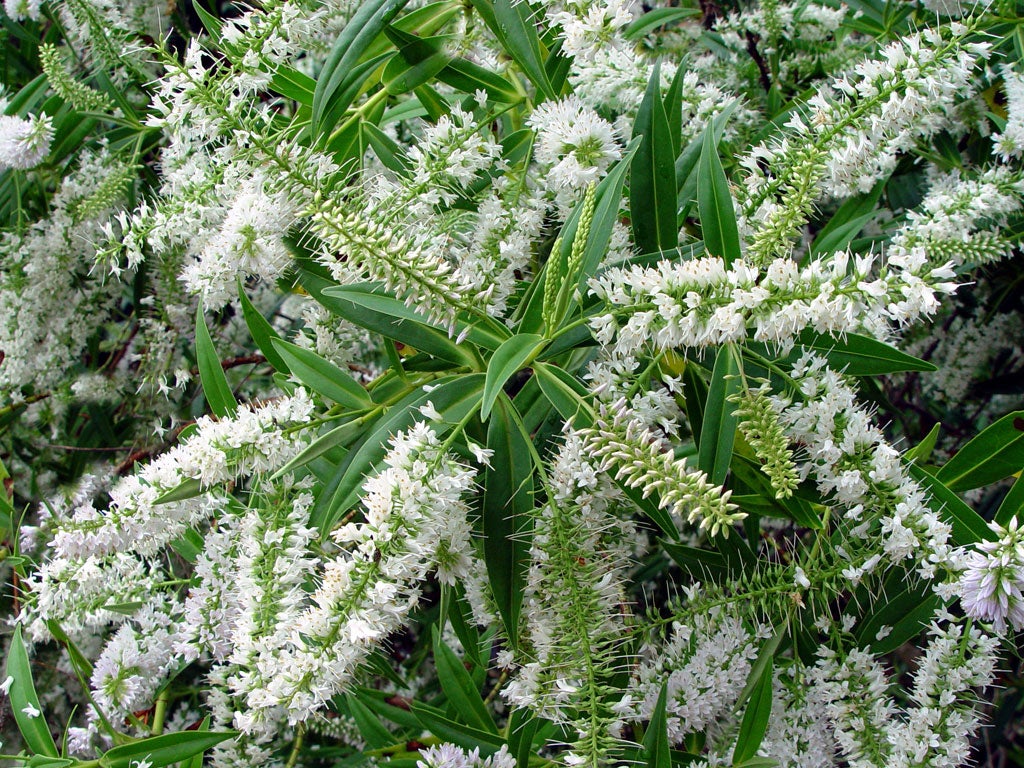Angel delights: Sing hallelujah to heavenly hebes, the most uncomplaining of plants

Hebes do get a bad press. Well, in fact, they get a bad everything. Stuffed into the flowerbeds of newly established supermarket car parks as "ground cover", they suffer all kinds of weather and a standard of care worthy of a 1980s Romanian orphanage. However, this noble and uncomplaining attitude has got them precisely nowhere. You will very rarely hear a gardener singing the praises of a hebe. (A short-staffed landscaping contractor, on the other hand, will sing hallelujahs.)
Which seems to me to be nuts. Scorning a plant because it has pretty evergreen leaves, flowers the whole summer long and is extremely challenging to kill? That's like scorning Charlie's Angels. It's time to stick up for hebes. Visit the West Country, or indeed any county that gets pounded by the sea, and hebes are a constant reminder of their own salt-tolerant greatness. Twined into the hedges with orange autumn crocosmia and clematis, providing floral windbreaks to shelter something more tender, or just (shock horror) planted on purpose for their own merits, these are lovely plants.
There are plenty to choose from, too: hebes are a big group. Some are tiny and sit well in tubs and window boxes (especially for those of us who, ahem, aren't all that good at remembering to water our containers). There's a small, silvery-green hebe whose leaves have a carmine line at the margin (see box, right), that is particularly lovely teamed up with something else that has a touch of rose – hellebores or tiny pink tulips, even.
Among my favourites, though, are the really big ones. Hebe salicifolia, whose Latin name means willow-leaved, has long, elegant leaves in just that style. It is also covered in nosy fingers of white flowers from the moment the weather turns even vaguely warm in spring, giving loads of interest for insects and butterflies (it's often the first place to spot a just-woken bumblebee in the new year).
Care-wise, you can't get away with actual murder, but not far off. Hebes are natives of New Zealand, and will flourish best in a rainy summer. Or when actually watered. What an idea. They can't get 100 per cent frozen in the winter either, or bits will go black and drop off. Or at least wilty. (If it's really going to freeze, run out with a black bin liner and wriggle it over the top of the plant for the night. Looks terrible, totally works.)
You can't chop them back quite as much as you like, either. The garden blogger Arabella Sock learnt this the hard way when she was advised by a celebrity gardener (who shall remain nameless) that she could, and promptly wiped hers out. Hebes respond well to pruning, but only if you cut back to stem that still has a couple of little leaves on it. Don't go too far into the wood, or you risk having a bare branch that looks as if lightning has struck, though the rest of it will live.
Ah, the uncomplaining plants are the best: good morning, angels.
Hallowed hebes
1. Hebe 'Red Edge'
These will never grow taller than mid-thigh, and will cheer your spirits on a cold day with their delicious grey-green leaves with pink edges. £4.99, rhsplants.co.uk
2. Hebe salicifolia
Flowers as good as a veronicastrum – so why isn't everyone going on about it? £5, trecanna.com
3. Hebe 'Mrs Winder'
This won an RHS Award of Garden Merit for its hard-working and pretty habit, with lovely deep-royal purple flowers all summer long. £4.99, rhsplants.co.uk
Join our commenting forum
Join thought-provoking conversations, follow other Independent readers and see their replies
Comments